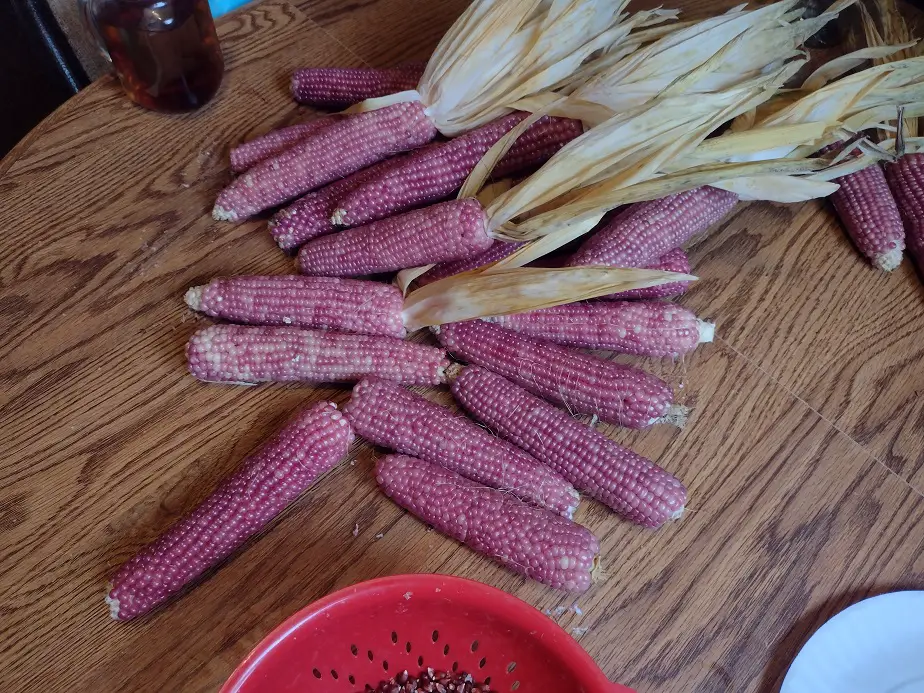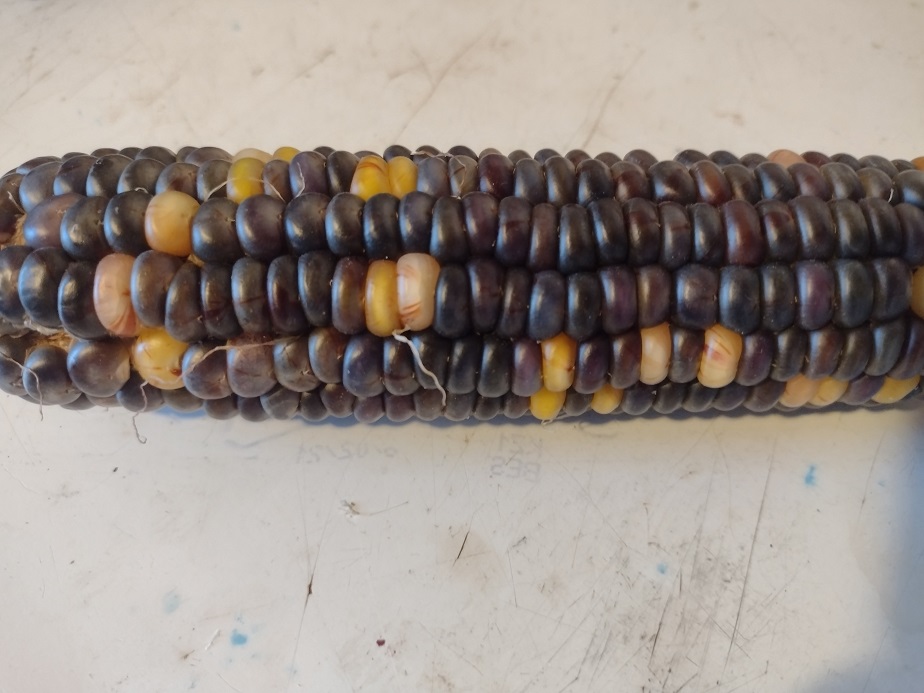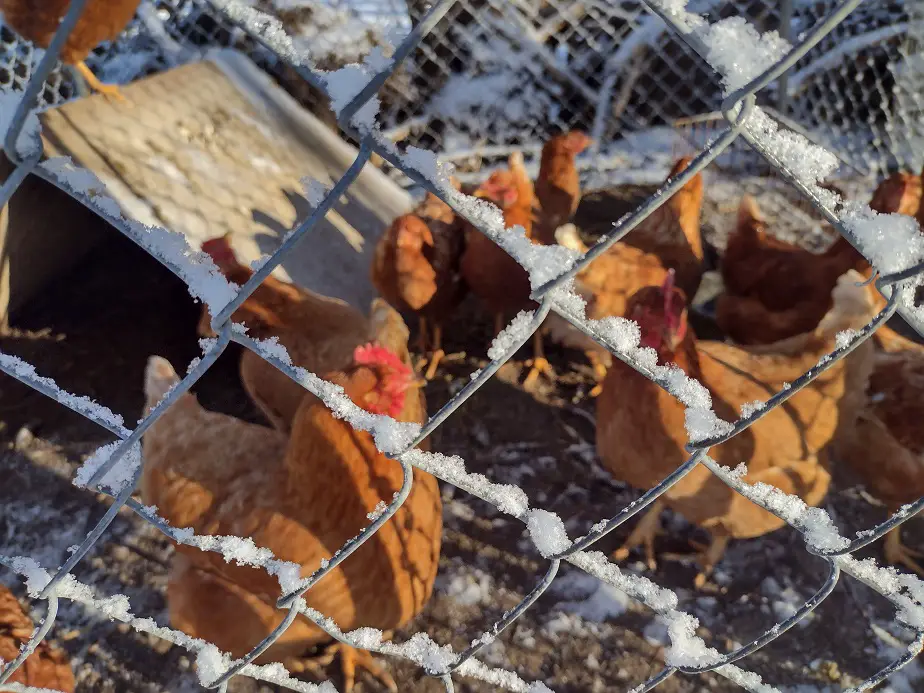Feed corn is one of the things I get into the most.
The best corn for chicken feed is a bright or multi-colored, organic flint corn. Flint corn has been shown to promote better growth, and red, blue, and orange hues offer valuable phytonutrients to animals. The most commonly used is a yellow dent corn hybrid with GMO components.
That’s the answer in short, but let’s get deeper.
Why is Organic Corn Better for Chickens?
Chickens fed Organic corn or organic feed have fewer issues with cancer, stronger immune systems, live longer, and are known to produce more nutritious meat and eggs. Organic chicken meat is also attributed to better gut health and fewer digestion complaints.
I have researched this extensively and was a bit shocked with the new information I learned. My main concern about organic vs non-organic chicken feed stems from how it ultimately affects my family. Eating eggs and meat from our birds, what they eat is passed to us and has an impact.
Organic corn can’t be a GMO, it can’t have most types of agricultural chemicals applied to it, and it has to be grown in tested, clean soil with clean water.
There are three primary concerns of non-organic corn. They are: Pesticides, herbicides, and fungicides. These chemicals used in corn fields, even though approved by the FDA, leave residues on and in corn that can pose a problem to your health and to your chickens.
Currently, the biggest issue is thought to be the herbicide glyphosate, aka Round-Up. Besides the argument of whether or not it’s legitimately attributed to cancer, it’s proven to disrupt the microbic balance of healthy gut function. The compound reacts through a specific enzyme pathway to kill plants.
It has been found that about half of good gut bacteria are impacted the same way and are killed off. Residue on grains and trace amounts in meat from animals that ate the grain have been proven to be strong enough to kill off those good bacteria in humans.
Here’s an article from Forbes if you don’t believe me.
This is connected to a host of digestive issues and immune problems, including gluten sensitivity, immunodeficiencies, and allergies. I even read one study linking that sort of digestive impact to autism. But, that’s another thing entirely.
Doctors and health authorities across the world are becoming concerned about glyphosate and its widespread use in farming after recent research shows its problems.
“It has also been linked to liver disease, birth defects and reproductive problems in laboratory animals; and may kill beneficial gut bacteria and damage the DNA in huma embryonic, placental and umbilical cord cells.”
Dr. J. Zimmerman
Chicken feed containing glyphosate has been proven to negatively impact the hatching rate of eggs through early embryo mortality. Here’s an article on Science Direct about that.

Why is GMO Corn Bad for Chickens?
Most GMO corn is sprayed with heavy doses of Glyphosate which poses extra concerns to us and our livestock. The most common GMO genome is “Round-Up Ready”, which is glyphosate-resistant. This means the weedkiller can be sprayed directly on the crop without killing it.
While GMO crops are not necessarily bad on their own, the heavier use of glyphosate seems to be a real concern and is proven to have negative impacts on our health. 80 percent of corn, soy, and oats in the US are glyphosate-resistant GMO. About 90 percent of the world’s crops are.
Generally, US farmers will do one or two extra applications of glyphosate with the GMO crop. In other countries, it’s often used more heavily.
Buying non-GMO corn or chicken feed is better because it shouldn’t have as much chemical residue in it. Organic is better yet because the chemicals known to be an issue are not allowed to be used on it at all.
We are working on switching our feed corn to organic grown flint corn, but it’s going to take a while to switch completely. After researching for this article, I want that now more than ever.

Why are Certain Colors of Corn Better?
Darker and bolder colored grains have higher levels of antioxidants, which greatly improves the health of poultry. The primary phytonutrients in corn are Beta carotene, found in orange plant pigments, and Anthocyanins, which come from purple and blue plant pigments.
One of my favorite corns for livestock feed is Atomic Orange. It’s a fairly new heirloom variety developed especially for its high levels of Beta carotene and use as livestock feed. It’s a moderately productive and early-maturing variety of soft flint corn. It’s also 30 percent higher in protein than common feed corn.
Flint corn, a corn containing harder and slower digesting starch, has also been shown to be better for livestock than common dent corn which has mostly al soft, faster-digesting starch.
Besides averaging higher protein, flint corn digests slower, which keeps their metabolism at a more even rate throughout the day; it keeps them fed longer. I have been growing Wade’s Giant Indian Corn for our animals. It’s a longer-season variety, multi-colored flint corn that has a lot of reds, oranges, and blues.
It’s a productive grower, but it’s sometimes hard for us to get it dry in time. I am trying Atomic Orange this year. We hope it goes well.
Most feed corn is a mild yellow. It has some beta carotene in it. Higher concentrations of beta carotene become more orange. Some feed corn is white. That stuff is mostly devoid of all phytonutrients and I don’t recommend it. Beta carotene, besides being a strong antioxidant, is associated with the production of vitamin A.
The photo nutrient known as Anthocyanin is an incredibly strong antioxidant. It’s responsible for the red and blue hues in corn. It ranges in strength quite a bit. We can rate it by pigmentation. Darker hues mean higher amounts of anthocyanin. From least to most: pink, red, blue, purple, black.
One overlooked point is that corn high in antioxidants stores much better without breaking down over time. It’s mostly oxidation that causes grain to go bad with age, and antioxidants counteract that.
So, my recommendations on corn for chickens:
- Non-GMO is good
- Organic is Better
- Orange and blue/purple is better than standard white or yellow
- Flint corn is better than dent corn
Here’s a paper from Biotech Articles on the importance of antioxidants in poultry.

Cracked Corn vs Whole Corn for Chickens?
Cracked corn is slightly easier for chickens to digest than whole corn, but a chicken’s gizzard can quickly adjust to fully process whole corn. Whole corn keeps better and does not require the additional processing of cracked corn. Enevn bantam chickens usually handle whole corn alright.
If you’re growing it yourself, There’s no need to crack the corn. Cracking is just a very coarse grinding that breaks the kernels into pieces roughly the size of a grain of rice. Cracked corn can get a little dusty due to all the starch, and it can mold a little easier. If you buy it, it’s usually a few dollars more per bag.
Our chickens get a lot of corn, but I’m personally not buying any cracked corn nor do I grind any of our home-grown corn. I don’t think it’s worth it. I don’t even shell our own corn, we feed it dried on the cob. Keep it simple.
Where to Get Good Corn?
The best way to get good corn is to grow it yourself or talk with a small farmer or homesteader who may grow you a small, custom crop. The commercial grain industry is not interested in growing non-GMO corn in spite of growing customer demand. Currently, Amish and Mennonite farmers grow most of the heirloom corn crops.
The reasons farmers don’t want to grow specialty crops of corn are that they are less productive, it’s harder to sell very large quantities of it, and it’s not supplemented with tax dollars like the modern corn crop industry.
I hope that in time, the demand for specialty corn crops will allow small farmers like me to profit off growing high-quality, natural grains for animal feed.
Related Articles:


Looking forward to your new youtube video’s thanks very much! Why not show the corn growing process. All the best. P.s check the carnivore dieet.